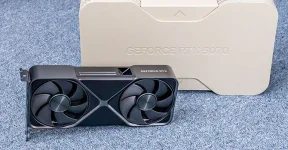NVIDIA dropped its new GeForce RTX 5070 Founders Edition card. They started their RTX 50 series launch quickly from the top with the 5090 and 5080 for serious gamers and then added the 5070 Ti between performance and enthusiast levels. The standard 5070 targets performance segment users who want 1440p gaming with everything maxed out, including ray tracing. You can buy it starting at $550, way cheaper than the 5070 Ti, which costs $750.
The RTX 5070 brings all the latest tech from the Blackwell architecture, like Neural Rendering, Hyper Geometry ray tracing support, and DLSS 4 Multi-Frame Generation. NVIDIA built the card using their third gaming GPU chip from Blackwell, GB205, which is almost at full capacity. They packed 12 GB of memory into a 192-bit GDDR7 interface. Memory size stays the same as before, but bandwidth jumps 33% compared to the RTX 4070.
Blackwell architecture introduces something revolutionary called Neural Rendering. This tech uses AI to create super realistic graphics by making neural objects that combine with traditional 3D graphics. NVIDIA worked with Microsoft to standardize this at the API level, giving programs direct access to Tensor cores. The system needs special hardware called AI Management Processor found only on Blackwell chips right ahead of older cards.
The new CUDA cores improve instructions per clock and can handle both FP32 and INT32 math on every core within each streaming multiprocessor. Older Ada chips could only do INT32 math on half their cores. They upgraded the RT cores to the fourth generation with special hardware for Mega Geometry, allowing much more complex ray-traced objects. Fifth-generation Tensor cores support the FP4 data format for faster processing.
NVIDIA created a smaller chip perfectly sized for the 5070 after seeing how many 4070 cards they sold. The GB205 chip has 50 streaming multiprocessors across five graphics clusters, but the 5070 uses 48 of them. This gives you 6,144 CUDA cores, 192 Tensor cores, 48 RT cores, and 192 TMUs. Unlike the 4070, which used only 64 of 80 possible ROPs, the 5070 uses all 80 ROPs from its chip.
The card runs PCI-Express 5.0 x16 and includes the latest video encoders and decoders. GPU clock speeds reach 2512 MHz boost with memory running at 28 Gbps, delivering 672 GB/s bandwidth. The 5070 uses all 48 MB of L2 cache on the chip. NVIDIA designed their Founders Edition with the same Dual Flow-Through cooler as bigger cards but made it much smaller, fitting small form factor cases.
The RTX 5070 needs 250 watts of power, which jumps 50 watts higher than the 4070. This happens because NVIDIA built Blackwell chips using the same 4N process as older Ada chips. Any efficiency gains come purely from architectural improvements rather than manufacturing changes. The Founders Edition card costs exactly $550, matching the starting price NVIDIA set for all 5070 cards.
The RTX 5070 brings all the latest tech from the Blackwell architecture, like Neural Rendering, Hyper Geometry ray tracing support, and DLSS 4 Multi-Frame Generation. NVIDIA built the card using their third gaming GPU chip from Blackwell, GB205, which is almost at full capacity. They packed 12 GB of memory into a 192-bit GDDR7 interface. Memory size stays the same as before, but bandwidth jumps 33% compared to the RTX 4070.
Blackwell architecture introduces something revolutionary called Neural Rendering. This tech uses AI to create super realistic graphics by making neural objects that combine with traditional 3D graphics. NVIDIA worked with Microsoft to standardize this at the API level, giving programs direct access to Tensor cores. The system needs special hardware called AI Management Processor found only on Blackwell chips right ahead of older cards.
The new CUDA cores improve instructions per clock and can handle both FP32 and INT32 math on every core within each streaming multiprocessor. Older Ada chips could only do INT32 math on half their cores. They upgraded the RT cores to the fourth generation with special hardware for Mega Geometry, allowing much more complex ray-traced objects. Fifth-generation Tensor cores support the FP4 data format for faster processing.
NVIDIA created a smaller chip perfectly sized for the 5070 after seeing how many 4070 cards they sold. The GB205 chip has 50 streaming multiprocessors across five graphics clusters, but the 5070 uses 48 of them. This gives you 6,144 CUDA cores, 192 Tensor cores, 48 RT cores, and 192 TMUs. Unlike the 4070, which used only 64 of 80 possible ROPs, the 5070 uses all 80 ROPs from its chip.
The card runs PCI-Express 5.0 x16 and includes the latest video encoders and decoders. GPU clock speeds reach 2512 MHz boost with memory running at 28 Gbps, delivering 672 GB/s bandwidth. The 5070 uses all 48 MB of L2 cache on the chip. NVIDIA designed their Founders Edition with the same Dual Flow-Through cooler as bigger cards but made it much smaller, fitting small form factor cases.
The RTX 5070 needs 250 watts of power, which jumps 50 watts higher than the 4070. This happens because NVIDIA built Blackwell chips using the same 4N process as older Ada chips. Any efficiency gains come purely from architectural improvements rather than manufacturing changes. The Founders Edition card costs exactly $550, matching the starting price NVIDIA set for all 5070 cards.












